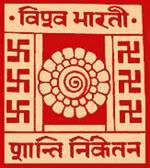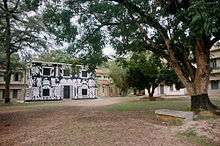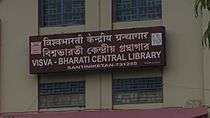Visva-Bharati University
|
'বিশ্বভারতী विश्वभारती | |
 | |
| Motto | Yatra Visvam Bhavatyekanidam |
|---|---|
Motto in English | Where the world makes a home in a single nest |
| Type | Centrally funded Autonomous university |
| Established | 1921 |
| Chancellor | Prime Minister of India |
| Vice-Chancellor | Vacant |
Academic staff | 515 |
| Students | 6,500 |
| Location | Santiniketan, West Bengal, India |
| Campus | Rural |
| Affiliations | UGC |
| Website | http://www.visva-bharati.ac.in |
Visva-Bharati University (Bengali: বিশ্বভারতী বিশ্ববিদ্যালয়) is one of India's major Central Government funded autonomous universities located in Santiniketan, West Bengal. It was founded by Rabindranath Tagore who called it Visva Bharati, which means the communion of the world with India. In its initial years Tagore expressed his dissatisfaction with the word 'university', since university translates to Vishva-Vidyalaya, which is smaller in scope than Visva Bharati. Until independence it was a college. Soon after independence, in 1951, the institution was given the status of a university and was renamed Visva Bharati University. The English daily, The Nation, notes, "Using the money he received with his Nobel Prize for Literature in 1913, the school was expanded and renamed Visva-Bharati University. It grew to become one of India's most renowned places of higher learning, with a list of alumni that includes Nobel-winning economist Amartya Sen, globally renowned filmmaker Satyajit Ray and the country's leading art historian, R. Siva Kumar, to name just a few."[1] On 4 April 2016 Visva-Bharati secured 11th rank ( All Indian Rank) in University category by National Institutional Ranking Framework, Ministry of Human Resource Development, Government of India.
History

The origins of the university date back to 1863 when Maharshi Debendranath Tagore, the zamindar of Silaidaha in East Bengal, was given a tract of land by Babu Sitikanta Sinha, the zamindar of Raipur,[2] which is a neighbouring village not far from Bolepur and present-day Santiniketan and set up an ashram at the spot that has now come to be called chatim tala at the heart of the town. The ashram was initially called Brahmacharya Ashram, which was later renamed Brahmacharya Vidyalaya. It was established with a view to encourage people from all walks of life to come to the spot and meditate. In 1901 his youngest son Rabindranath Tagore established a co-educational school inside the premises of the ashram. Pramatha Chaudhuri From 1901 onwards, Tagore used the ashram to organise the Hindu Mela, which soon became a centre of nationalist activity. Through the early twentieth century the zamindars of Surul (Sarkar Family), another neighbouring village, a few minutes by cycle from the Uttarayan Complex, and the zamindars of Taltore, a village just north of the university town, continued to sell their lands and other properties to the ashram and the college that was being built on this spot.[3]

On 23 December 1921, Tagore formally started the college with proceeds from the prize money of the Nobel Prize he received in 1913 for the publication of his book of poems Gitanjali. The college also became a centre of Brahmo learning in this period. It was granted full university status in May 1951 by the government of independent India. The poet's youngest son, Rathindranath Tagore, became the first upacharya (vice chancellor) of the new university. Another member of the Tagore family who performed the role of upacharya was Indira Devi Chaudhurani, a niece of the poet.
Rabindranath Tagore believed in open air education and had reservations about any teaching done within four walls. This was due to his belief that walls represent conditioning of mind. Tagore did not have a good opinion about the Western method of education introduced by the British in India; on this subject, Tagore and Gandhiji's opinion matched. Tagore once said, "I do not remember what I was taught, I only remember what I learnt." Tagore's idea on education was that every person is genius and that all students may not bloom at the same time. So he devised a new system of learning in Visva-Bharati. He allowed students to continue their course till the student and his teacher both are satisfied.
At Visva-Bharati University, if a course demanded by a student is not available, then the university will design a course and bring teachers for that course. The university would not be bothered by the consideration of whether there is a demand for the course.
| Upacharyas |
|---|
|
Administration
The high officials of the university include the paridarshaka (visitor), acharya (chancellor), and the upacharya (vice chancellor). The paridarshaka of this university is the president of India, while the acharya is the prime minister. The university is run by its Karma Samity (Executive Council) which is chaired by the acharya. The institutes and departments are located in both Santiniketan and Sriniketan.
Academics
The university is divided into institutes, centres, departments and schools. The respective departments are included in the institutes. The university's programmes dealing with its rich cultural heritage, as well as art and dance education, are funded by the Department of Science and Technology (DST), Government of India.
Institutes and museums
- The Cheena Bhavana (Institute of Chinese Language and Culture) was founded in April 1937 with the great vision of Tagore. Tagore invited Prof. Tan Yunshan to serve as the first chairperson of Cheena Bhavana. International scholars such as Jan Yun-hua worked at the Cheena Bhavana on topics ranging from Sino-Indian studies, Buddhism and Chinese philosophy. Chiang Kai-shek and Zhou Enlai donated a large number of Chinese books to the institute, making it one of the most important libraries for classical Chinese studies in India.
- Darshan Bhavana (Institute of Philosophy): This department is well known for its research and teaching. Jiten Mohanty has been associated with the work of this department.
 Kala Bhavan, Santiniketan.
Kala Bhavan, Santiniketan. - The Kala Bhavana (Institute of Fine Arts) is arguably one of the most well-known of the departments, it boasts an extremely well-known faculty and student body. It is most famous for the spread of Bengal School of Art. Abanindranath Tagore, one of India's most eminent artists was one of its founders and chief patrons. Luminaries such as Abanindranath Tagore, Gaganendranath Tagore, Nandalal Bose, Binode Bihari Mukherjee, Ramkinkar Baij, Dinkar Kaushik, K.G. Subramanyan, A. Ramachandran and R. Siva Kumar have either taught or been students here while Beohar Rammanohar Sinha did both, studying 1946-51 and then teaching 1953-56 and 1959-62.
- Palli Charcha Kendra (Sriniketan)
- Palli-Samgathana Vibhaga (PSV) (Institute of Rural Reconstruction) (Sriniketan)
- Palli Siksha Bhavana (Institute of Agricultural Science) (Sriniketan)
- Rabindra Bhavana (Institute of Tagore Studies and Research) (Uttarayan complex): Swapan Chakrabarty is the director of this institution.
- Sangeet Bhavana (Institute of Dance, Drama & Music): The eminent Rabindrasangeet singer, Kanika Bandyopadhyay was a principal of Sangeet Bhavana. Next Principal was another eminent singer, Nilima Sen.
- The Siksha Bhavana (Institute of Science) includes the Department of Biotechnology (DBT Funded, Govt of India), Zoology(CAS) Centre for Environmental Studies, Physics, Chemistry, Mathematics, Statistics, Computer Science, and Botany .
- Silpa Sadan (Institute of Craft and Design) (Sriniketan) is a reputed institute of Visva Bharati engaged in promoting crafts and design education which was set up by Gurudev Rabindranath Tagore in 1922 to uplift craft and craftsmen, thereby improving the rural economy.
- Computer Centre (Centre for Instruction, Research and Extension Activities)
- Rural Extension Centre (Sriniketan)
- The Vidya-Bhavana (Institute of Humanities & Social Sciences) includes the humanities and social science departments, such as the Department of History and the Department of Economics.
- Vinaya Bhavana (Institute of Education)
Associated institutes
Both institutes are now affiliated with the West Bengal University of Technology (WBUT), which was formed to bring all engineering education under different universities in West Bengal under a single umbrella. IIIT Kolkata (International Institute of Information Technology) was renamed to IERCEM Institute of Information Technology after its affiliation with the WBUT.
Schools
- Patha Bhavana: It is not only the oldest school of the university but also the oldest institution on which the university was subsequently built. It is the university school of Santiniketan. Initially called Ashram Vidyalaya it was later called Santiniketan Vidyalaya. It was started by Tagore in 1901. The distinctive features of this co-educational school include its open-air classrooms and emphasis upon oriental learning. The school, being the nucleus of the university and the town is within the Santiniketan Ashram. The first four students of the school included Tagore's son Rathindranath Tagore, the first upacharya of the university and Sudhi Ranjan Das, a chief justice of India. The future Nobel Laureate in economics, Amartya Sen, graduated from this school. So did one of the first Indian Rhodes scholars, Asim Datta. Supriyo Tagore, a great grandson of Satyendranath Tagore, the eldest brother of the poet, was one of its longest serving and most well known Principals. The eminent historians, Tapan Raychaudhuri and Ashin Dasgupta have periodically taken classes here.
- Mrinalini Ananda Pathsala: Founded in 1954 it was named after Rabindranath Tagore's wife Mrinalini Devi. It is a preparatory school for Patha Bhavana. It is housed in the Notun Bari and Dehali.
- Santosh Pathsala: Founded in 1988 it is kindergarten named after Santosh Chandra Majumdar. It is a preparatory school for Siksha Shastra.
- Siksha Shatra: It was founded in 1924. It was later shifted to Sriniketan in 1927. The students are from the neighbouring villages.
- Uttar Shiksha Sadana: This school was started in 1976.
Library
Visva-Bharati Library was established in 1901, at the time of foundation of the Brahmacharya Asrama at Santiniketan by Rabindranath Tagore. Presently, Visva-Bharati Library System has a Central Library, 12 Sectional libraries attached with Cheena-Bhavana, Siksha-Bhavana, Patha-Bhavana, Darshan Sadan, Hindi-Bhavana, Sangit-Bhavana, Palli Sangathan Vibhaga, Vinaya-Bhavana, Rabindra-Bhavana, Palli Siksha Bhavana, Kala-Bhavana and Siksha-Satra. Moreover, around 30 Seminar Libraries are in operation attached to different departments. The library has around 6,500 users, of which 350 users visit Central Library per day and daily transaction is of 300 books.

Visva-Bharati library contains old and rare documents, which include multi-lingual and multi-discipline books, reports, manuscripts, etc. The library also has a number of important collections; mention may be made of the collections of Rabindranath Tagore, Prabodh Chandra
Guest houses
The university has two guest houses: Ratan Palli, named after the eminent early twentieth century industrialist and scion of Tata family, Sir Ratan Tata, and Purba Palli.
Campus life

The twin towns of Santiniketan and Sriniketan are surrounded by Bolpur to the north, Kheya to the south, Surul to the east and Prantik to the west. The towns and the university are not far from the river Kopai which flows to the south.
This university is especially famous for its cultural festivals:
- Basanta Utsab (Spring Festival): This festival is identified with doljatra or holi, which is held on the grounds in front of Patha Bhavana.
- Poush Mela (Winter Fair): It is the annual winter fair which is held every Poush which coincides with December on Purono Melar Maath opposite the ashram and next to the Uttarayan complex, as well as on Melar Maath (Bhubandangar Maath), which is next to the administrative block. The fair is meant to encourage the local people of Birbhum and outlying districts to come and exhibit and sell their wares. Jatras, such as Alkap, are staged and Bouls perform at the fair. On the first day of the fair, (23 December), the university organises an Upasana Sabha at Chatimtala (under a chatim tree), the spot where Maharshi Debendranath Tagore established his ashram for the first time in 1863. On 24 December the university organises a display of lights and fireworks on Melar Maath, a custom started by the poet, Rabindranath Tagore himself. On Christmas Day, the university organises the Christo Utsab, which is meant as a mark of respect for all religions.
Notable alumni
University
- Satyendra Nath Bose, known for his fundamental work in Quantum Physics.
- Ghani Khan, Renowned Pashtun poet and son of Khan Abdul Ghafar Khan (Frontier Gandhi)
- Amartya Sen, celebrated economist and Nobel laureate
- Ramkinkar Baij, eminent sculptor and painter
- Syed Mujtaba Ali, novelist and littérateur
- Kanika Bandyopadhyay, eminent singer
- Nabakanta Barua, eminent novelist
- Nabakrushna Choudhuri, former chief minister of Orissa
- Rezwana Chowdhury Banya, singer
- Mahasweta Devi, noted author
- R. Siva Kumar, noted art critic, curator and India's leading art-historian, ex-principal, Kala Bhavan
- Savitri Devi, actress
- Santidev Ghosh, author, singer and dancer
- Somnath Hore, eminent printmaker, sculptor, ex-principal Kala Bhavana
- Suchitra Mitra, eminent singer
- Guru Kelu Nair, Kathakali maestro
- Ruma Pal, judge, Supreme Court of India
- Satyajit Ray, filmmaker and writer
- Beohar Rammanohar Sinha, renowned painter who solely illustrated the Preamble to the Constitution of India and other pages, disseminated Indian art in the Peoples Republic of China while mastering their art and lacquer work. Disciple of Nandalal Bose, Benode Behari Mukherjee, Ramkinkar Baij and teacher of A. Ramachandran at Santiniketan.
- K.G. Subramanyan, eminent artist, writer, ex-dean M S University, Baroda and professor emeritus Visva Bharati University
- Subinoy Roy, singer
- Brajendra Nath Seal, vice chancellor of University of Mysore
- Nilima Sen, eminent singer
- A. Ramachandran, eminent artist
- Shivani, author
- Jogen Chowdhury, eminent artist
- Kailash Chandra Meher, artist
- Swastika Mukhopadhyay, singer, professor Sangit Bhavana
- Chitra Dutta, scientist
School (Patha Bhavana, originally Santiniketan Vidyalaya)
- Sudhi Ranjan Das, ex-chief justice of India
- Gayatri Devi, maharani of Jaipur
- Santidev Ghosh, adhyaksha, Sangeet Bhavana, Visva-Bharati
- Amartya Sen, master, Trinity College, Cambridge, Nobel laureate in Economics
- Mukul Dey, pioneering printmaker and graphic artist. First Indian principal, Government School of Art & Craft, Kolkata
- Kalyan Banerjee, president, Rotary International 2011-2012[4][5]
Eminent academics
- Charles Freer Andrews, Vice Principal, Westcott House Theological College, Cambridge
- Ramkinkar Baij, Head of the Sculpture Department, Visva-Bharati University
- Nandalal Bose, Principal, Kala Bhavan
- Tan Chung, Director, Cheena Bhavan
- Leonard Knight Elmhirst, Founder of Dartington Hall
- Gourgopal Ghosh, Mohan Bagan football player
- Vincenc Lesny, Indologist and Iranian studies scholar
- Sylvain Levi, French Asianist
- P. C. Mahalanobis, Director, Indian Statistical Institute, Calcutta
- Benode Behari Mukherjee, Curator, Nepal Government Museum, Kathmandu
- Shahid Suhrawardy, Nizam professor, and scholar on Iranian art
- Rajat Kanta Ray, see list of upacharyas
- K.G. Subramanyan, Professor Emeritus, Visva-Bharati University, Santiniketan
- Abanindranath Tagore, Founder of Bengal School of Art
- Giuseppe Tucci, Italian Asianist
- Beohar Rammanohar Sinha, Dean Indira Kala Sangeet University, Director, Govt Inst of Fine Arts (GIFA), Jabalpur.
- R. Siva Kumar, Principal, Kala Bhavan and noted art-historian
- Moriz Winternitz, Librarian, Indian Institute, Oxford
- Shakti Chatterjee, poet
- Affandi, Indonesian painter
- Prabodh Chandra Bagchi, Sino-indologist
- Harold Peiris, Artist and scholar
- Gyula Germanus, Islamologist
See also
References
- ↑ http://www.nationmultimedia.com/life/Exploring-Mother-Indias-cradle-of-art-30206439.html
- ↑ The most famous son of the zamindari family of Raipur was Lord Satyendra Prasanno Sinha, the first Indian governor of Orissa and Bihar (1919-1920). Other well-known members of the same family included his younger brother Major N.P. Sinha, an IMS officer, as well as one of his six grandsons, Mohit Sen, a well-known communist ideologue and writer of the latter half of twentieth century India.
- ↑ The entire neighbourhood of Purbapalli belonged to the former zamindars of Taltore.
- ↑ "Kalyan Banerjee Rotary International President-Elect". Show Me Rotary. Missouri District 6040, 6060, 6080. Retrieved 2 July 2011.
- ↑ "The presidents of Rotary International 1997-98 to 2011-12". Rotary Global History Fellowship (An internet project). Rotary Global HIstory Fellowship. Retrieved 1 July 2011.
External links
| Wikimedia Commons has media related to Visva-Bharati University. |
